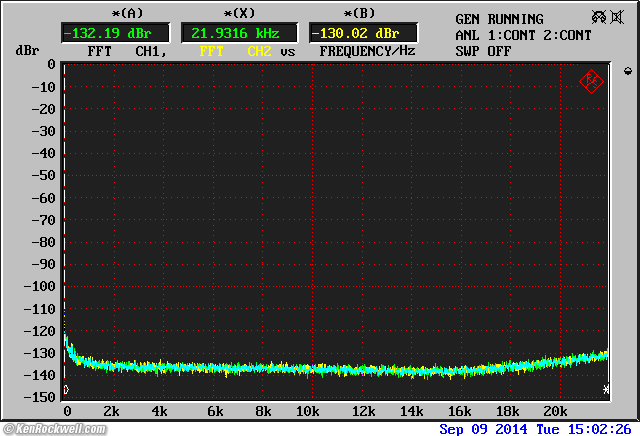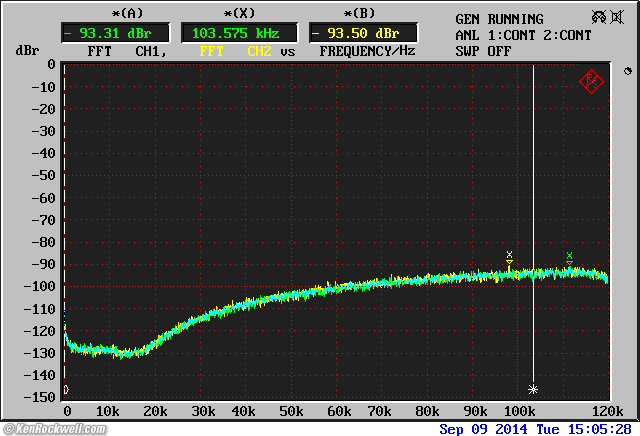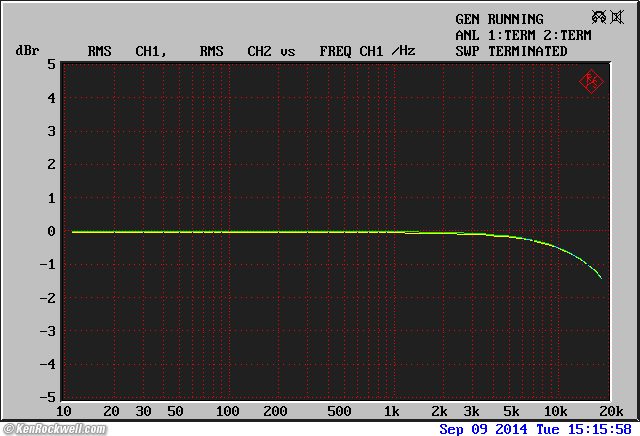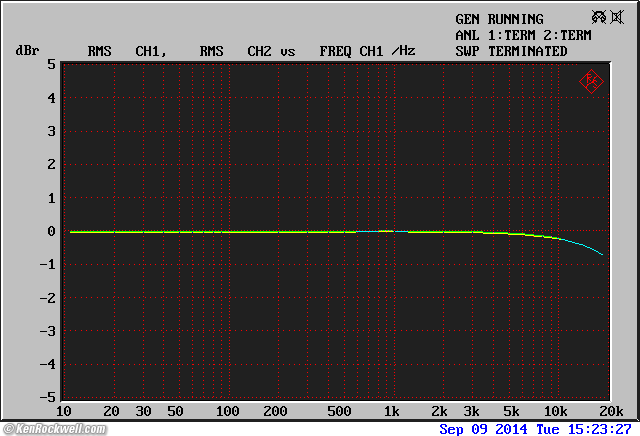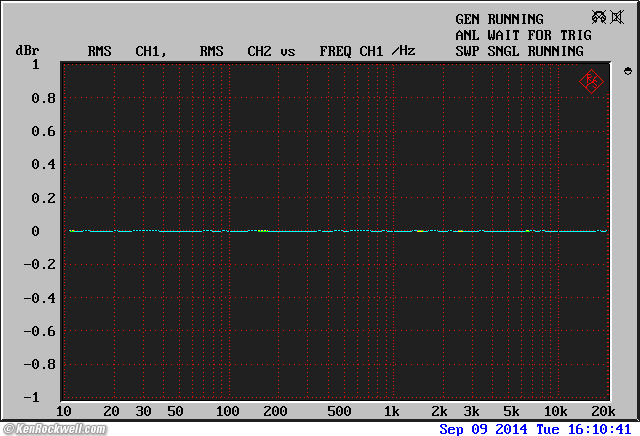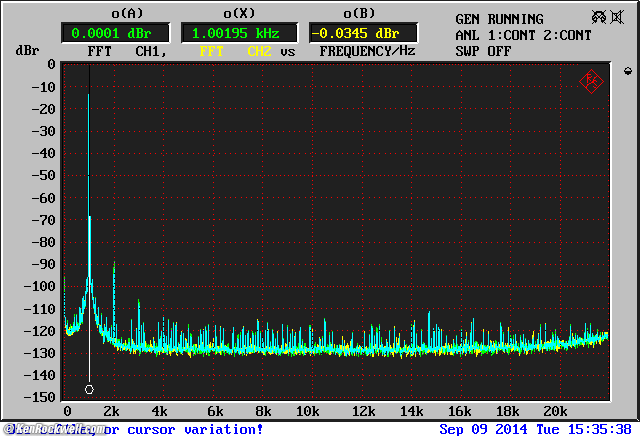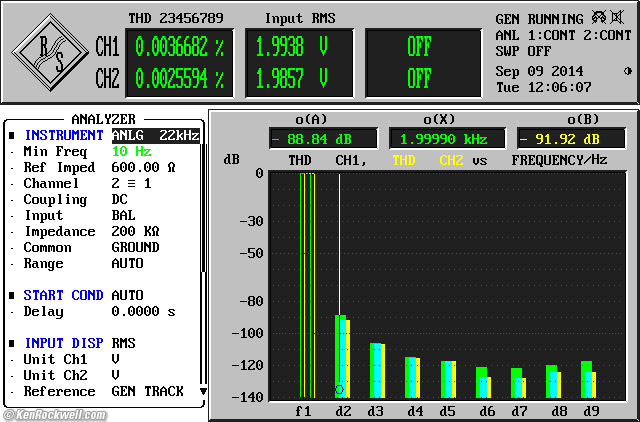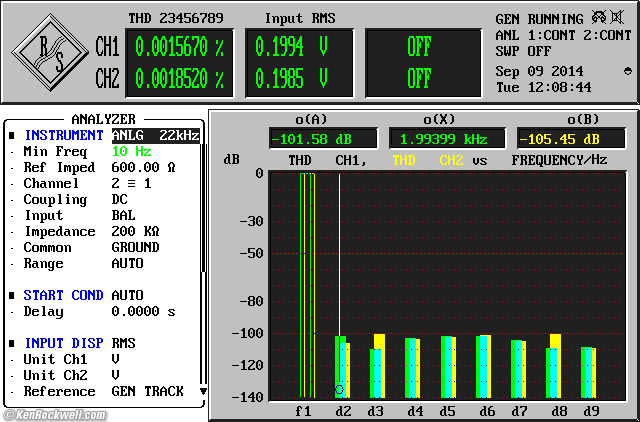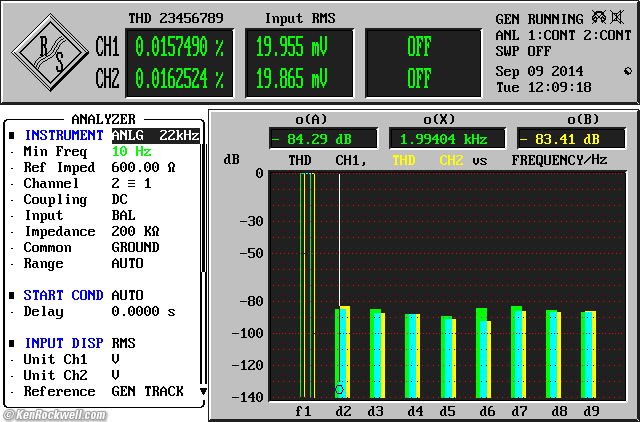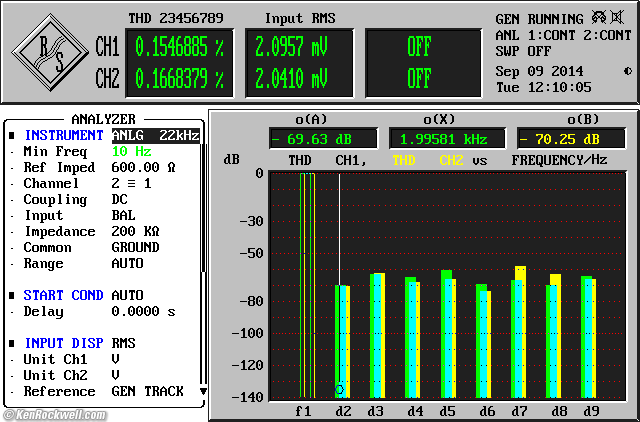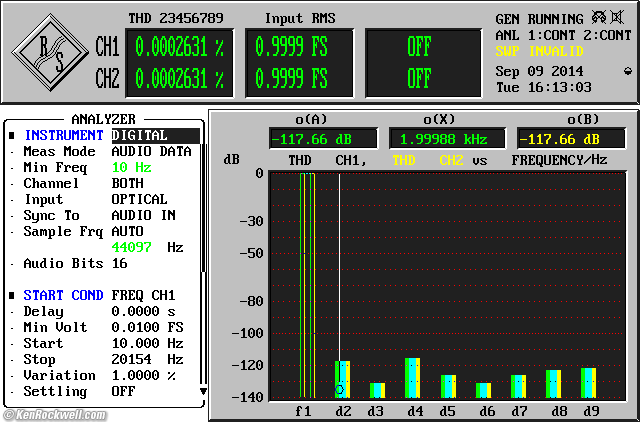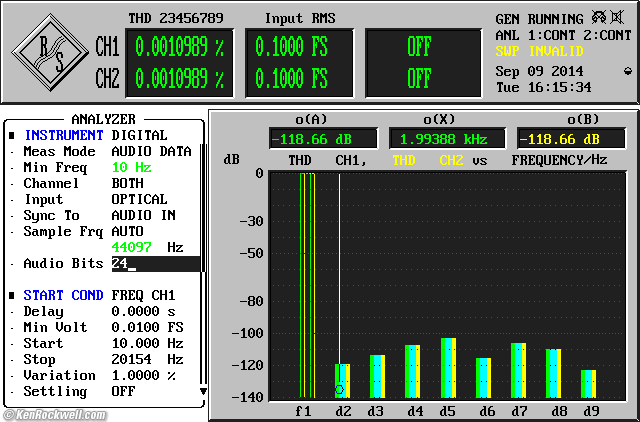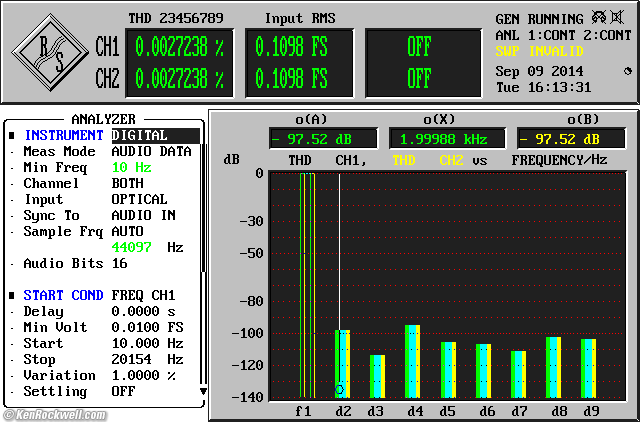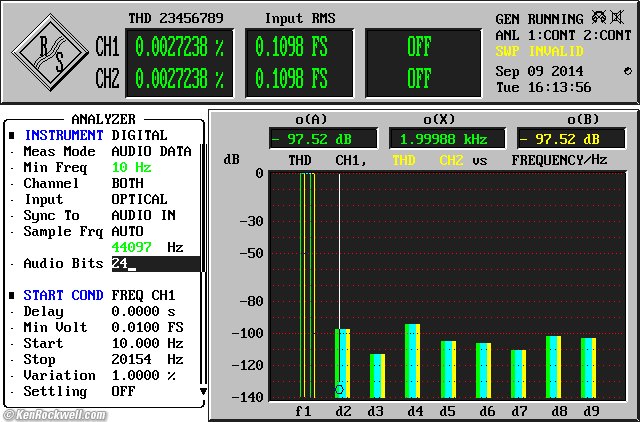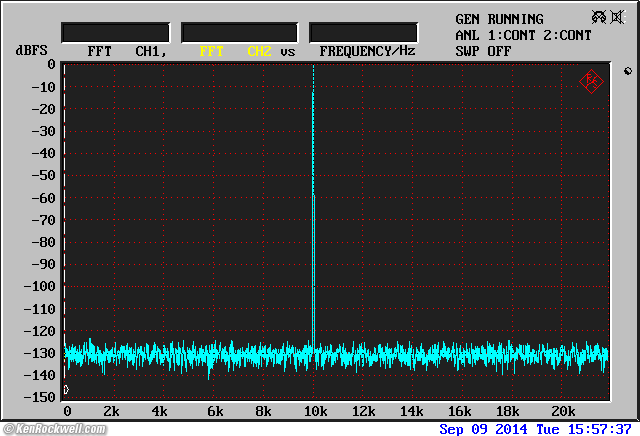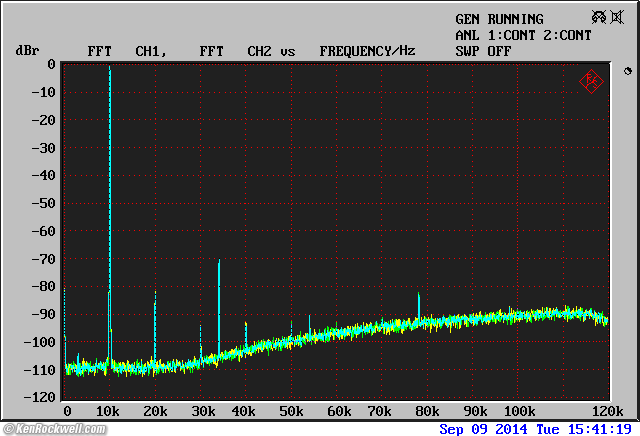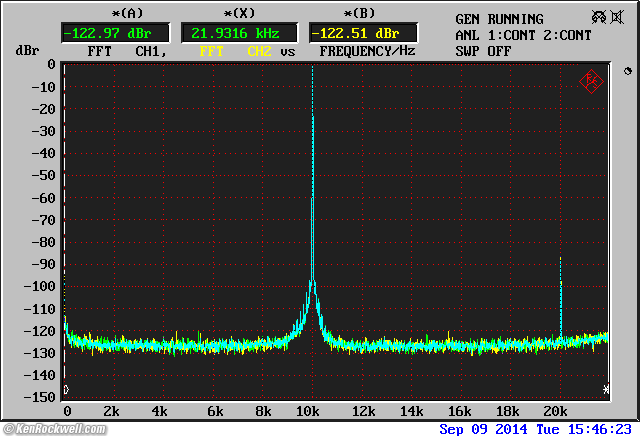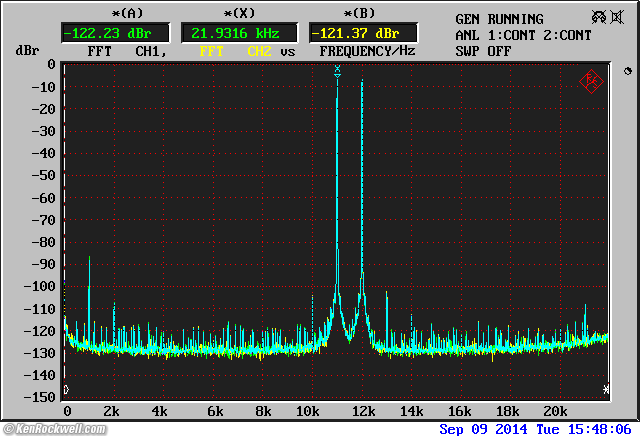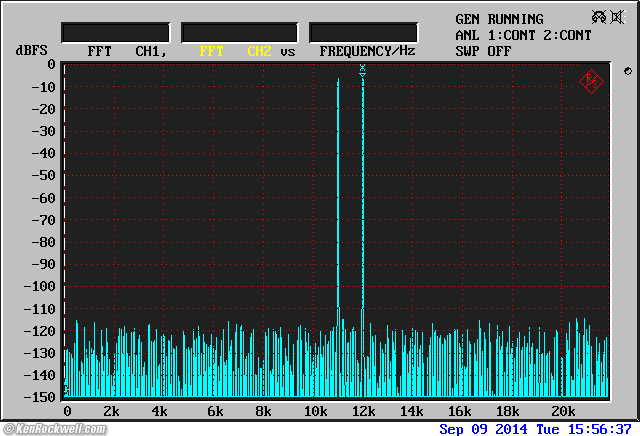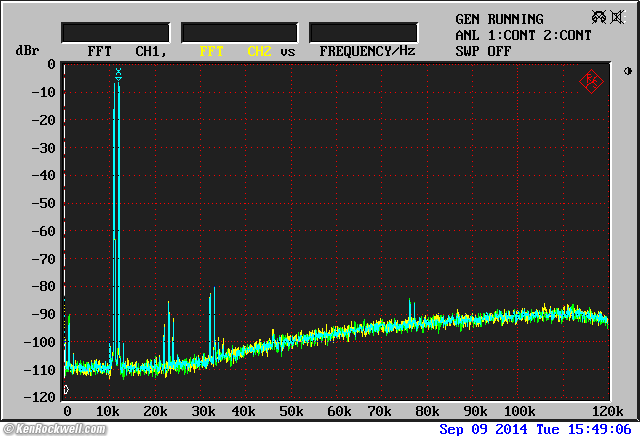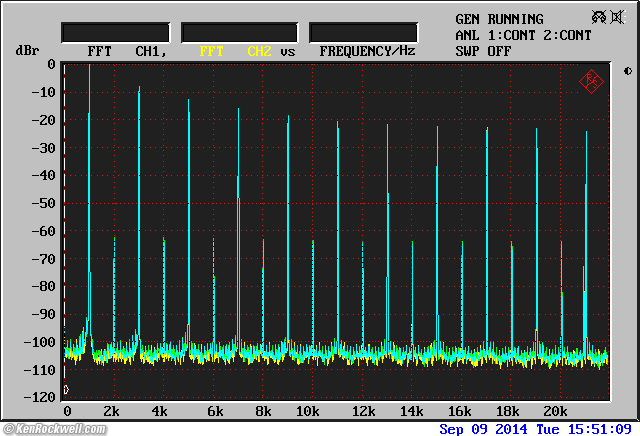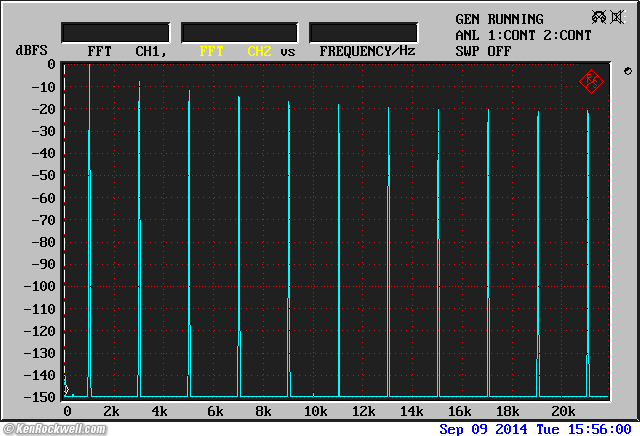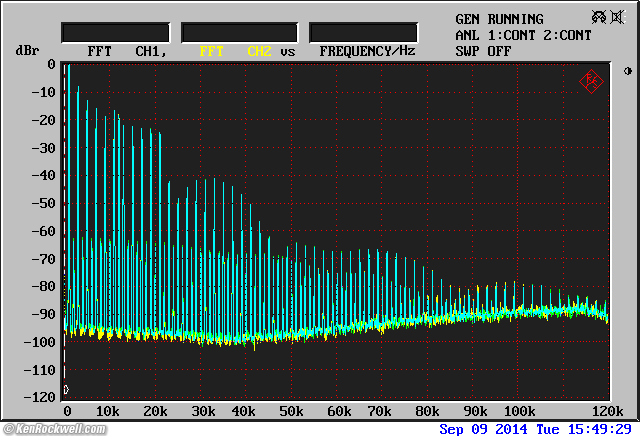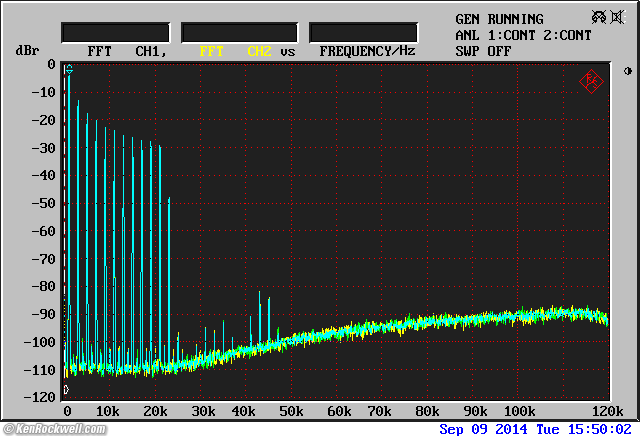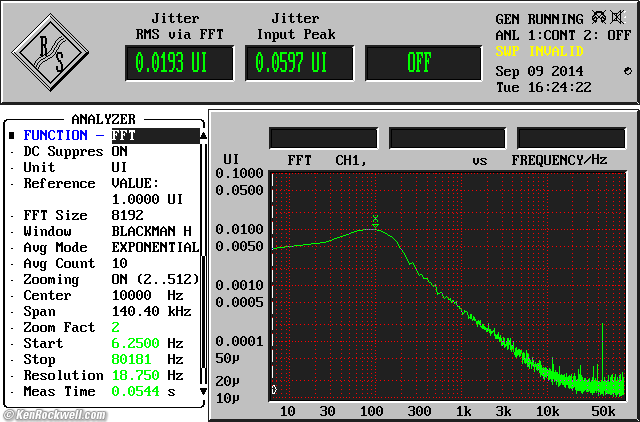Home Donate New Search Gallery Reviews How-To Books Links Workshops About Contact
Apple AirPort Express Audio Performance
Model A1392 / MC414LL/A (2014)
Intro Specs Measurements Recommendations
Apple AirPort Express (8.3 oz./235 g, about $35 used if you know How to Win at eBay.
This free website's biggest source of support is when you use that or any of these links when you get anything, regardless of the country in which you live. Thanks! Ken.
Apple AirPort Express.
February 2023 All Reviews > Audio Reviews > Apple reviews
How to Make a Large Wireless Network
How to Make a Multi-Room Audio/Video System
See also the audioengine B1 Bluetooth Audio Receiver and old AirPort Express.
Good: Fantastic audio quality, full 2 V RMS output, beautiful, sturdy build and small.
Bad: Much clumsier to set up the first time than Bluetooth.
Introduction top
Intro Specs Measurements Recommendations
This Apple AirPort Express can be used as a high-perfomance DAC to play-out from a Mac or iOS device over AirPlay, WiFi, or a wired Ethernet connection.
It's easy to configure a slew of them to sit in different rooms of your home, and play to them from your devices.
Simply plug the AirPort express into your HiFi, stereo, power-amplifier, home music system or powered speakers, and it will play from your iOS device or your Mac.
Use a 3.5mm cord to connect to many powered speakers.
Use a 3.5mm to RCA cord to connect to any stereo system or power amp or preamp, or many other powered speakers.
Since you can control the volume from your device or Mac, you can skip the preamp for even better fidelity; just plug it directly into your power amplifier.
Use a Mini TOSLINK cable to connect directly to the optical SPDIF digital inputs of a DAC or stereo receiver. The AirPort Express has its own great DAC, but if you prefer to use another, no problem.
The TOSLINK output is the same connector as the 3.5mm analog connector. You can use only one at a time. Use a Mini TOSLINK cable to plug into other TOSLINK SPDIF inputs.
Specifications top
Intro Specs Measurements Recommendations
Model Number
A1392.
Marketing Product Number
MC414LL/A.
Inputs
Wi-Fi and Ethernet.
Outputs
Stereo 3.5mm analog at 2 V RMS, Mini-TOSLINK optical digital SPDIF (same jack).
Power
110-240 VAC 50-60 Hz.
Actual consumption at 120 VAC: 2.3 watts.
Included
Cool Apple power cord.
The power cord is so nice that some rich folks in Leichtenstein buy these just for the cords for other equipment, and throw away the AirPort Express!
Mechanical
Plastic case.
Size
About 4" (12 cm) square.
Weight
8.275 oz. (234.6 g), actual measured.
Quality
Made in China.
Price
About $35 used if you know How to Win at eBay in February 2023.
$100 or less when new in 2014-2015.
Measurements top
Intro Specs Measurements Recommendations
Output Levels Output Impedance Noise & DC Offset
Channel Balance Frequency Response THD
Output Spectra & Square Waves Digital Output Jitter
Low-Level Linearity Power Consumption
These are measured with a $50,000 Rohde & Schwarz UPL laboratory analyzer as calibrated by Rohde & Schwarz.
Unless otherwise noted, all are RMS as measured from the analog output loaded with 200 kΩ at 0 dBFS at 1 kHz. Signals are from the CBS CD-1 test CD as transferred into iTunes as an ALC (Apple Lossless) file, and played via iTunes from a Mac Pro in iTunes 11.1.5 in OS 10.9.4 over a Wi-Fi connection from a much larger home network.
The traces are color coded for the Left Channel and for the Right Channel. When they don't lie on top of each other, it's due to channel imbalance.
Output Levels measurements top
at 0 dBFS |
Volts |
dBV |
200 kΩ load |
1.991 V |
5.98 dBV |
600 Ω load |
1.5885 V |
4.02 dBV |
300 Ω load |
1.3216 V |
2.42 dBV |
This is the same as a standard CD player (2 V) and 6 dB more than an iOS device (1 V).
Output Source Impedance measurements top
152 Ω.
Noise & DC Offset measurements top
Noise
Playing digital zeros, 22 kHz bandwidth:
Level |
SNR* |
ENOB** |
|
A-weighted |
-97.3 dBV |
103.3 dB |
16.9 bits |
Unweighted |
-93.0 dBV |
99.0 dB |
16.2 bits |
* referred to maximum output.
** Effective Number of Bits : (SNR - 1.72 dB) / 6.0206.
I read the same values with iTunes in the Mac Pro paused.
FFT while playing zeros. (CBS CD-1 track 4, R&S UPL.)
Wideband FFT while playing zeros. (CBS CD-1 track 4, R&S UPL.)
DC Offset
+1.36 mV left, +3.19 mV right.
Channel Balance measurements top
The right channel is 0.036 dB lower than the left.
This is marvelous and inaudible. You don't want to know how much "audiophile" gear hits my lab that has its channels out of balance by close to a dB or more, which you can hear.
Frequency Response measurements top
Analog output at 0 dBFS, 200 kΩ load. (CBS CD-1 track 11, R&S UPL.)
That's pretty flat.
Yes, it rolls off a bit at the top, and that will make it sound even smoother and warmer. You can pay $3,000 for a 35-pound Sony SCD-XA777ES and engage the special digital filter mode to get the same effect, or just use the AirPort Express.
Here's the response measured at the extremes:
Frequency |
Response |
4 Hz |
0.0 dB |
8 Hz |
0.0 dB |
17 Hz |
0.0 dB |
32 Hz |
0.0 dB |
. |
. . . |
2 kHz |
0.0 dB |
4 kHz |
-0.09 dB |
8 kHz |
-0.29 dB |
10 kHz |
-0.44 dB |
12.5 kHz |
-0.66 dB |
16 kHz |
-1.01 dB |
18 kHz |
-1.25 dB |
20 kHz |
-1.54 dB |
It's got about the same high frequency rolloff as the special digital filter mode of the Sony SCD-XA777ES, and it's got perfect response to infrasonics.
Let's load it with 300Ω, as if a pair of Hi-Fi headphones were plugged in directly, and see what happens:
Analog output at 0 dBFS, 300 Ω load. (CBS CD-1 track 11, R&S UPL.)
Aha, a little flatter.
Here's the frequency response via the TOSLINK optical digital output:
Digital output frequency response. (CBS CD-1 track 11, R&S UPL.)
Perfect, as expected.
THD: 0.003% (-90 dB) measurements top
FFT while playing 1 kHz at 0 dBFS. (CBS CD-1 track 1, R&S UPL.)
Analog output harmonic content, undithered 1kHz sine wave at 0 dBFS. (CBS CD-1 track 1, R&S UPL.)
Ahhh, almost entirely musical second harmonic distortion. Most people have to buy tube amps to get this.
Let's play tracks at low levels and see what happens:
Analog output harmonic content, undithered 997 Hz sine wave at -20 dBFS. (CBS CD-1 track 18, R&S UPL.)
Perfect, it's got even less distortion at -20 dBFS where it counts. Are we sure there aren't some Nuvistors or a 12AX7 in there?
Let's keep dropping the recorded level:
Analog output harmonic content, undithered 997 Hz sine wave at -40 dBFS. (CBS CD-1 track 18, R&S UPL.)
Analog output harmonic content, undithered 997 Hz sine wave at -60 dBFS. (CBS CD-1 track 18, R&S UPL.)
Just for fun, let's see how much of this minimal distortion is from the AirPort Express DAC, and how much is inherent in the undithered 16-bit signal:
TOSLINK digital output harmonic content, undithered 1kHz sine wave at 0 dBFS. (CBS CD-1 track 1, R&S UPL.)
As expected, the digital output has no distortion. For comparison, let's also look at it at -20 dBFS:
TOSLINK digital output harmonic content -20 dBFS. (CBS CD-1 track 18, R&S UPL.)
Again, no distortion. This was with a recording at -20 dBFS. Let's see if anything changes if we play a 0 dBFS recording and drop the playback level with iTunes slider volume control:
TOSLINK digital output harmonic content playing 0 dBFS tone with iTunes play volume at -20 dB, 16-bit analysis. (CBS CD-1 track 1, R&S UPL.)
Just for fun, lets analyze the datastream in 24-bit mode and see if Apple is reditheing to 16 bits, or using more bits as the play volume is lowered:
TOSLINK digital output harmonic content playing 0 dBFS tone with iTunes play volume at -20 dB, 24-bit analysis. (CBS CD-1 track 1, R&S UPL.)
I see no changes; I'll presume only 16 bits are used. I was too lazy to pull out my Tek 764 to see which bits are wiggling or not.
I'm actually measuring the digital datastream itself in a laboratory, no DAC required. This is what comes out of the TOSLINK output, and what a perfect DAC would output.
Output Spectra measurements top
10kHz 11+12kHz IMD Square Wave
Let's see a zoomed FFT of a 10 kHz sine wave. Let's see what sort of spurs surround the carrier, which show us internal jitter:
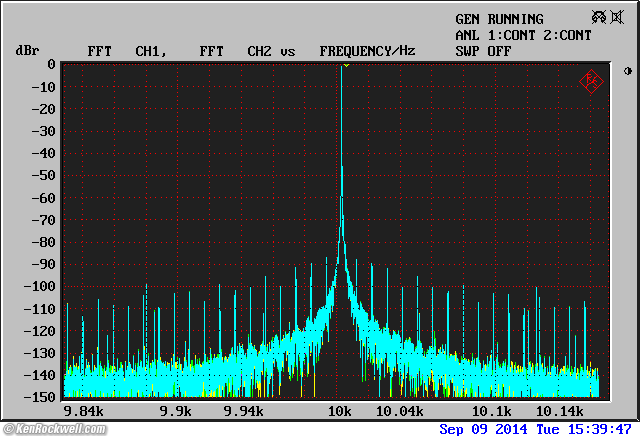
Zoomed spectrum of 10,007 Hz 0 dBFS sine wave. (CBS CD-1 track 9, R&S UPL.)
The crud is higher than from a great CD player, but at least there's very little jitter (spreading of the skirts). I can't heat any noise this low, even if a CD player direct analog output might be 30 dB better at this. Bluetooth is horrible by comparison here. Since we can't hear any of this, this is where lossy coding piles the garbage. The AirPort Express uses no lossy coding, so that's why it's so much cleaner than anything via Bluetooth.
Just for fun, let's see if anything changes if we lower the playback level in iTunes:
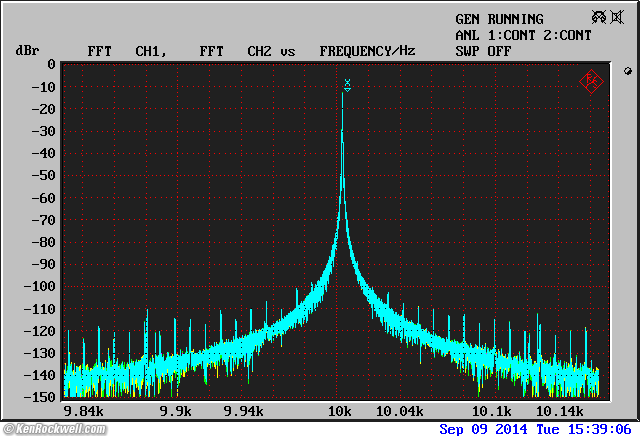
Spectrum of 10,007 Hz 0 dBFS sine wave, -6 dB playback level in iTunes. (CBS CD-1 track 9, R&S UPL.)
It's a little better, but not that much. Let's look at the TOSLINK SPDIF digital output:
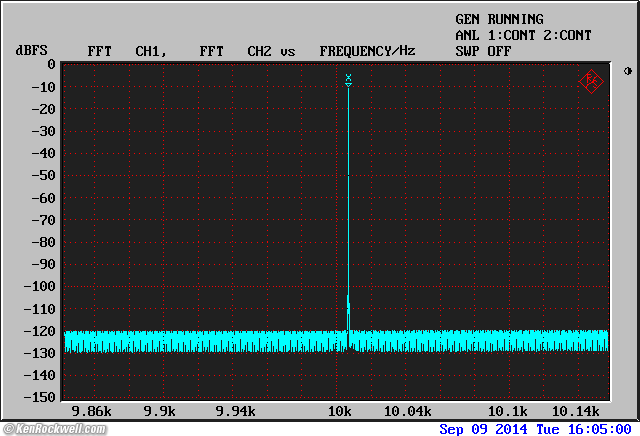
TOSLINK output: spectrum of 10,007 Hz 0 dBFS sine wave. (CBS CD-1 track 9, R&S UPL.)
As expected, it's perfect — and precise enough to show that I really use a 10,007 Hz, not 10 kHz, test signal here.
These are super-close-in FFTs looking mostly at jitter. Let's look at it wideband:
TOSLINK output: spectrum of 10,007 Hz 0 dBFS sine wave. (CBS CD-1 track 9, R&S UPL.)
As expected, the TOSLINK output is perfect.
Here's the analog output in a 110 kHz bandwidth:
Wideband spectrum of 10,007 Hz 0 dBFS sine wave. (CBS CD-1 track 9, R&S UPL.)
Aha! See the raised noise above 25 kHz? That's where the DAC is putting the noise: up where we can't hear it.
Here's a look at just the audible band:
Spectrum of 10,007 Hz 0 dBFS sine wave. (CBS CD-1 track 9, R&S UPL.)
Let's see how 11+12 kHz IMD look:
IMD spectrum at 11 kHz and 12 kHz 1:1. (CBS CD-1 track 13, index 2, R&S UPL.)
Much cleaner than Bluetooth! I can't even plot Bluetooth on the same vertical scale. The Sony SCD-XA777ES is better.
Here's the same thing direct from the TOSLINK output:
IMD spectrum at 11 kHz and 12 kHz 1:1. (CBS CD-1 track 13, index 2, R&S UPL.)
Perfect.
Here it it wideband, from the analog output of course:
IMD spectrum at 11 kHz and 12 kHz 1:1. (CBS CD-1 track 13, index 2, R&S UPL.)
Nothing troubling here, just some harmonic distortion spikes and shaped noise.
Let's look at square waves:
1,002.27 Hz 0 dBFS square wave. (CBS CD-1 track 16, R&S UPL.)
This is very good, far better than Bluetooth and better than most outbopard DACS. =what this shows us =is that the AirPort Express won't distort or do anything crazy when playing modern CDs that are recorded at 110%.
Here is is via TOSLINK:
TOSLINK output, 1,002.27 Hz 0 dBFS square wave. (CBS CD-1 track 16, R&S UPL.)
Perfect, as expected for a direct digital transfer.
Just for fun, let's look wideband at the analog output again:
1,002.27 Hz 0 dBFS square wave. (CBS CD-1 track 16, R&S UPL.)
Let's reduce the playback level about 6 dB in iTunes and see what happens:
1,002.27 Hz 0 dBFS square wave. (CBS CD-1 track 16, R&S UPL.)
Aha! That ultrasonic hash, typical in the SACD format, goes away with the playback levels at any reasonable level. Especially if you turn Sound Check ON, you'll never play anything at this foolish a level anyway.
Square Wave measurements top
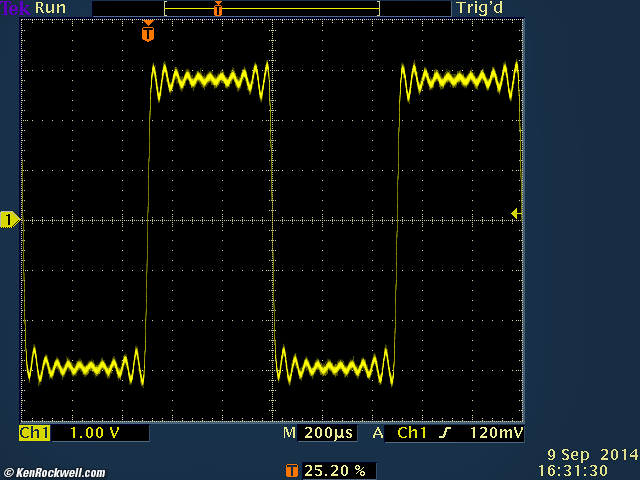
1,002.27 Hz 0 dBFS square wave at full playback level in Mac Pro. (CBS CD-1 track 16, TEK TDS3052.)
This is nearly perfect. A bandlimited square wave is supposed to look wiggly like this, but the edges ought to be a little peakier.
Let's lower the playback volume in iTunes and see what happens:
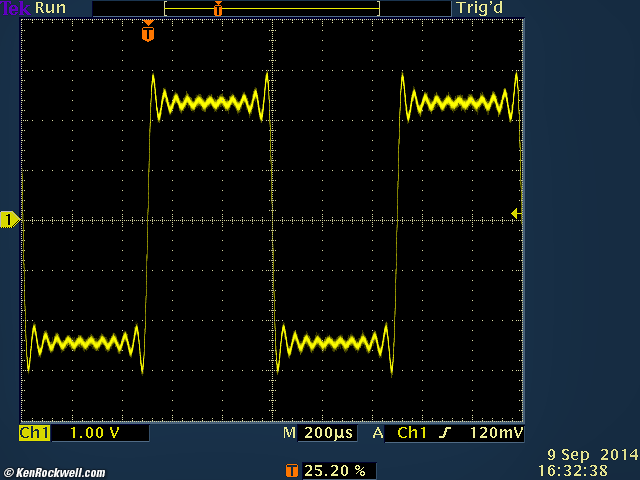
1,002.27 Hz 0 dBFS square wave played with Mac Pro volume down a bit. (CBS CD-1 track 16, TEK TDS3052.)
Bingo! Perfection! Few modern digital audio devices can give waveform fidelity like this. Bravo!
Digital Output Jitter measurements top
Digital output jitter spectrum. (CBS CD-1 track 1, R&S UPL.)
Aha! As a digital source to feed another DAC, the AirPort express output has even less jitter than the Sony SCD-XA777ES (not that anyone would ever hear this).
This level of jitter is effectively zero.
Low-Level Linearity measurements top
The 500Hz dithered fade-to-noise test (track 20 on the CBS CD-1 test CD) sounds great out to 24 seconds, or -108 dBFS, when played from an iOS device. Not bad for a 16-bit system!
Actual Power Consumption measurements top
2.3 W from 120 VAC, regardless of what it's doing.
Recommendations top
Intro Specs Measurements Recommendations
As I suspected, the TOSLINK output is perfect; any audible limitation here is the AirPort's DAC and your source material. As far as I can tell short of comparing bit-for-bit, the optical digital output is a perfect copy of the original, the whole point of digital audio.
The AirPort Express DAC is also very, very good. In some ways it's not quite as good as a $3,000 CD player, and in others it's even better. I'm very happy, this new AirPort Express has much better analog audio quality than the old AirPort Express.
What's superb about this AirPort is that it has a full 2 Volt RMS output, not a whimpy 1 V or less output as we get from the jacks of iOS devices or many other and more expensive outboard DACs.
It's more difficult to set up than Bluetooth, but has no coding loss to affect the audio that Bluetooth does.
At any price, the Apple AirPort Express is a great DAC. It sounds great, with a completely silent background, full 2 V output, smooth detailed sound and full infrasonic bass response.
For best results, leave your player's volume at its maximum for maximum output from the AirPort Express, and then vary the playback level with your Hi-Fi's volume control.
If you find my research helpful, this free website's biggest source of support is when you use these links, especially this link to them at eBay (How to Win at eBay) when you get anything, regardless of the country in which you live.
Thanks!
Ken.
Help me help you top
I support my growing family through this website, as crazy as it might seem.
If you find this page as helpful as a book you might have had to buy or a workshop you may have had to take, feel free to help me continue helping everyone.
If you've gotten your gear through one of my links or helped otherwise, you're family. It's great people like you who allow me to keep adding to this site full-time. Thanks!
If you haven't helped yet, please do, and consider helping me with a gift of $5.00.
As this page is copyrighted and formally registered, it is unlawful to make copies, especially in the form of printouts for personal use. If you wish to make a printout for personal use, you are granted one-time permission only if you PayPal me $5.00 per printout or part thereof. Thank you!
Thanks for reading!
Mr. & Mrs. Ken Rockwell, Ryan and Katie.
Home Donate New Search Gallery Reviews How-To Books Links Workshops About Contact





